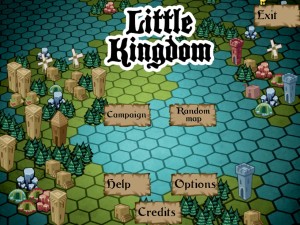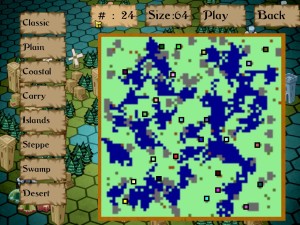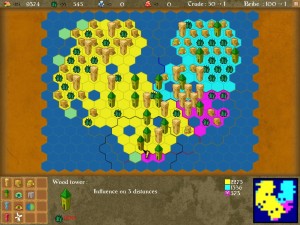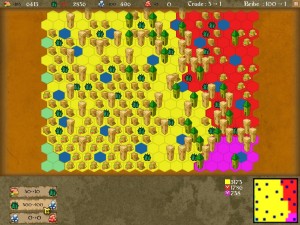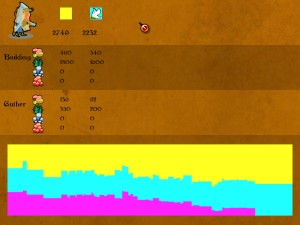As a fan of the board game, “Settlers of Catan” and the more recent “Star Trek Catan”, I was excited to get my hands on this particular strategy game. “Little Kingdom” is an RTS that focuses on resource gathering and fighting over land, via a top down view of a hexagonal battlefield. Before we begin taking a look at this game in further detail, I’d like to thank the folks at Andreil Game for sending me a free review copy.
The main menu gives you the option to play the campaign, participate in a skirmish battle, view a help menu, and adjust game options. The help menu simply brings up a small screen that gives you an overview of the game mechanics, something I’d recommend reviewing before trying your hand at either the campaign or skirmish mode. The options menu features a full screen toggle, screen resolution toggle, and music / sound sliders. There isn’t a way to view the control scheme, but I rarely used anything except for the mouse. I should also note that “Little Kingdom” is a single player experience only, which I’ll touch on later.
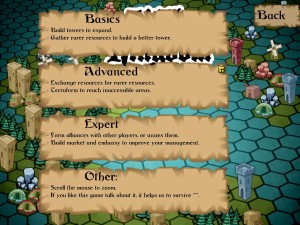
The help menu will give you a few things to keep in the back of your mind when playing for the first time.
The campaign’s first few levels will put you through your paces via a tutorial. Pop-ups will explain the game mechanics and the information scattered around the interface. If you’d rather try your luck with the random map / skirmish mode, you’ll be able to assign the map size, AI difficulty, the number of opponents, which players are on what team, and what the map’s shape should look like. The larger the map, the more AI opponents you can have. I managed to get the game to allow for 24 players on the size 64 map, but I’d recommend starting smaller on your first few playthrus.
The interface is very simple and easy to read, though it may take some thought to understand what is going on. Along the top of the interface is a list of all of the resources that are available in the game. The white number indicates what you currently have of that resource and the black or red number indicates a change, based on the current situation…more on that in a bit. The trade ratio indicates how much you’d have to sell of an item (the first number) to acquire the desired resource (the second number). Finally, the bribe ratio determines how much it will cost to ally or annex an opponent. Along the bottom are the available buildings, you and your opponents’ scores, and the minimap.
The goal of every map is to eliminate every other color but yours. To do that, you’ll need to build towers that influence the hexes around them, turning them into your color. Towers come in various strengths as indicated by the type of resource it takes to build them. Clay towers are the easiest and only require food, but only influence up to a hex distance of two. Stone towers, on the other hand, cover significantly more ground. Acquiring the stone you’ll need to build these towers is a whole different matter.
Besides towers, you can build sawmills and other resource buildings near the resource in question to gather them. If a particular resource is out of reach (outside of your color), you can trade with the bank for it, though at the ratio indicated along the top of the interface. Clicking anywhere in your territory will bring up a trade menu, allowing you to trade food for wood, wood for stone, and stone for iron. Clicking on one of them will start a slow, automatic transfer of resources while clicking more will increase the value of the trade. Resetting back to 0:0 cancels the trade.
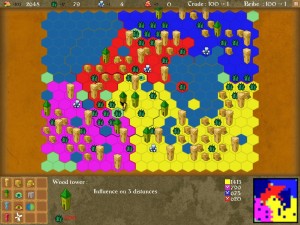
Resources can be scarce when the map gets busy…trading becomes viable, assuming the ratio isn’t too bad.
The gameplay mechanics took me a playthru to understand them fully, but once I caught on to what was going on, I saw all new strategies that I hadn’t considered before. For one, towers become more expensive as you build or acquire more in your territory. What’s more, this mechanic works for each tower type separately…that is, having a bunch of clay towers will make them almost unaffordable, but if you have little to no stone towers, they will still be cheap. This prompted me to sell towers that weren’t really all that useful, which drove down the price of that particular tower type. It’s all about being efficient and aggressive at the same time, and the constantly changing territories kept me on my toes. Trading becomes viable only if you build a lot of markets, which drives down the trade ratio along the top.
Overall, there is a lot to like about this game. There are plenty of different ways to approach a situation. You can concentrate on building sawmills to gather wood, for example, or stick to acquiring land and use the excess food to trade for wood instead. The campaign doesn’t contain a lot of missions, but you’ll find it challenging nonetheless. I personally like the random map / skirmish feature as it gives you plenty of options to customize your experience. I had a hard time distinguishing between the difficulty icons…I wasn’t sure which one was easy, medium, or hard. I also couldn’t change my color in skirmish…but that is a minor complaint. While it would definitely flourish in the multiplayer market, it does well on its own as a single player experience. In the grand scheme of things, I believe that $4.99 is a fair price for the content that this game offers. Whether you’re in the mood for a quick five-minute match or an hour-long war, “Little Kingdom” delivers.
Final Verdict: 7/10
—
You can learn more about and purchase “Little Kingdom” by visiting the following websites:
http://andreilgame.e-monsite.com/pages/our-games/pc.html
http://www.desura.com/games/little-kingdom
https://www.facebook.com/AndreilGame
You can view play sessions here:
http://www.youtube.com/watch?v=xIX2vLNyKwY

